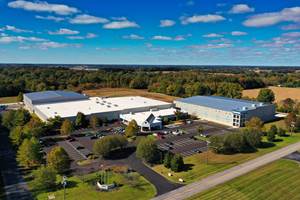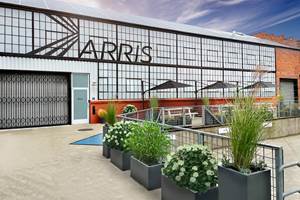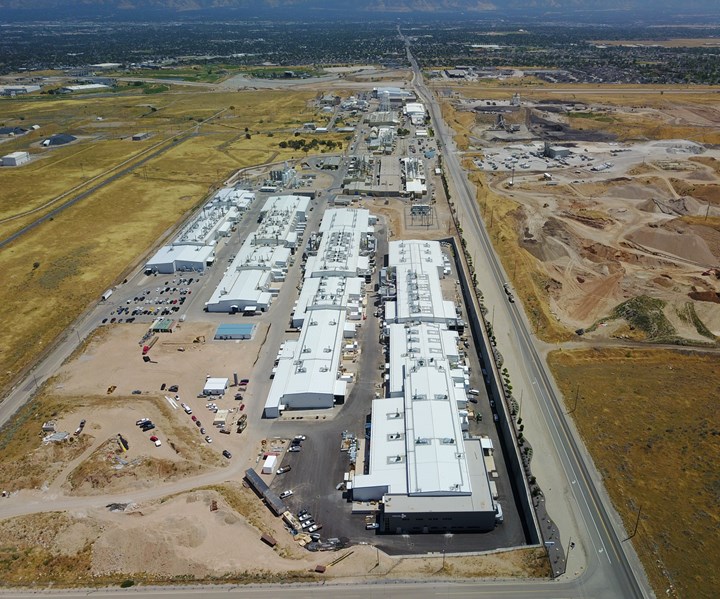
This aerial view of Hexcel’s Salt Lake City campus features the company’s newest carbon fiber lines in the foreground, including lines 13 and 14, located in the building second from the right. Carbon fiber manufacture in this building began in 2016. Source | Hexcel
The apparently simplistic nature of the chemical composition of carbon fiber — carbon atoms organized in chains of hexagonal graphitic structures — might give one the impression that its manufacture is similarly simple. The production of carbon fiber is, after all, a chemical process that uses heat, tension and time to transform an organic precursor fiber (usually polyacrylonitrile) into carbon fiber that is then organized into multi-filament tows and wound onto a spool for delivery to customers — weavers, prepreggers and composites fabricators.
The resulting product is one that — pound for pound — offers strength, stiffness and durability unlike any other manufacturing material the world has to offer. It’s a critical component of commercial and defense aircraft structures, car and truck structures, wind turbine blades, marine vessels, sporting goods and much more. It has, over the last 40 years, evolved from being an obscure, rarely used and difficult-to-process advanced material, to become a staple of the modern manufacturing material palette. The global supply of carbon fiber — and its attendant demand — are watched closely as barometers of the health of the global composites manufacturing industry.
In truth, however, the “simple” chemical transformation that is the manufacture of carbon fiber, even if it has progressed tremendously since its modern inception in the late 1960s, is a complex, capital-intensive and daunting process only practiced well by a handful of companies throughout the world. Each of these producers has a long history of manufacturing carbon fiber and relies on a carefully cultivated and closely held formula that provides a much-valued competitive advantage. (This story is not a full accounting of the carbon fiber manufacturing process; for that, see CW’s “The making of carbon fiber.”)
It is for these reasons that gaining access to a modern carbon fiber manufacturing line is difficult to achieve. However, Hexcel (Stamford, Conn., U.S.), one of the world’s largest suppliers of carbon fiber, opened its doors to CompositesWorld and offered a glimpse of the scale, precision, speed and quality that are hallmarks of a world-class carbon fiber production process.

Carbon fiber manufacture at Hexcel starts with hundreds of creels, like this one, of PAN precursor. Hexcel calls these creels “cheeses,” which is a textile term derived from the fact that the material at this stage looks like a cheese wheel. Tows of PAN are unwound, tensioned and then delivered to the first stage of carbon fiber manufacture: oxidation. Source | Hexcel
What Hexcel is
The carbon fiber line CW was allowed to visit is located on the company’s sprawling carbon fiber manufacturing campus in West Valley City, Utah, U.S., just southwest of Salt Lake City. This location is home to 14 carbon fiber lines, including the company’s oldest and newest. Hexcel also has carbon fiber manufacturing in Illescas, Spain, and Roussillon, France, as well as polyacrylonitrile (PAN) production in Decatur, Ala., U.S., and Roussillon. All told, the company has annual, global and nameplate capacity of more than 16,000 metric tonnes of carbon fiber, with 95% of that coming from the Salt Lake City campus, which produces 45,000 miles of carbon fiber tows each day. Hexcel is second only to Toray (Tokyo, Japan) in total carbon fiber production capacity, and is the world’s largest producer of aerospace intermediate modulus carbon fiber.
Of course, like most carbon fiber manufacturers, Hexcel produces other products as well, including resin systems, prepregs, tapes, fabrics, adhesives, honeycomb cores, tooling materials and some finished parts and structures. Most of this business, however, revolves around the company’s HexTow carbon fiber brand, which includes well-known products like AS4 and AS7 (high strength); IM7, IM8, IM10 and IMA (intermediate modulus); and HM50, HM54 and HM63 (high modulus).
Most of the carbon fibers Hexcel manufactures are available in tow counts of 3K, 6K and 12K, which are targeted primarily toward aerospace, defense and other high-performance applications. Hexcel is the primary supplier of carbon fiber prepreg to Airbus for the A350 XWB aircraft and delivers total product content valued at approximately $4.8 million for each aircraft. The company had 2019 sales of approximately $2.5 billion and is in prime position to compete with Toray, Teijin, Solvay and others for placement of carbon fiber on next-generation aircraft expected from Boeing and Airbus over the next decade as well as emerging automotive, urban mobility and energy segments.

As the PAN is unwound from the cheeses, each tow passes over a winder near the ceiling and aligned side-by-side. These tows, which span about 2 meters wide, then pass under another winder near the floor of the plant and then horizontally through a gap in the wall to enter the oxidation oven. Source | Hexcel
How it got here
All of this might have seemed unlikely when Hexcel was founded in 1946, near San Francisco, as California Reinforced Plastics, producing honeycomb core. The founders, Roger Steele and Bud Hughes, attended the University of California at Berkeley and focused on development of honeycomb core/glass fiber sandwich structures for use in aerospace manufacturing. The company, started in Hughes’ basement, managed to win a few defense contracts before, in 1954, changing its name to Hexcel Products Inc. Along the way, as production operations matured, Hexcel moved into a true manufacturing facility in Berkeley.
In 1962, Hexcel’s materials were applied to the Friendship II capsule, which carried U.S. astronaut John Glenn into Earth orbit. Throughout the 1960s and 1970s the company grew, acquiring ancillary businesses, and expanded outside the U.S. Hexcel saw its products applied on NASA’s Space Shuttle and, in 1986, the company built a production facility in Arizona to support its involvement in the B-2 bomber program.
By 1993, however, Hexcel had spread itself too thin, began to struggle financially and filed for Chapter 11 bankruptcy, emerging two years later after restructuring and reorganizing. Soon after, in possibly the most important acquisition in the company’s history, Hexcel in 1996 acquired Ciba-Geigy’s composites business, as well as the composites operations of Hercules, based in Salt Lake City. In the process, the company moved its global/corporate headquarters from California to Connecticut.
Up until this point, Hexcel’s products for composites manufacturing included prepregs, fabrics, core materials and adhesives. With the acquisition of Hercules, Hexcel for the first time entered the business of carbon fiber manufacturing. Hercules, for its part, began carbon fiber manufacturing in Salt Lake City in 1971, using precursor and production technology developed by and licensed from textiles and chemistry giant Courtaulds (Coventry, U.K.), and then Sumitomo (Tokyo, Japan). Hercules, a supplier of parts for defense and weapons systems, was compelled to sell its carbon fiber business in 1996 following a series of program cancellations that created excess capacity in the carbon fiber market.
What followed for Hexcel, after the acquisition of the Hercules business, was two decades of substantial growth that very much mirrored the expansion of the composites industry itself, driven by carbon fiber application in several high-profile defense and aerospace programs. These included the Airbus A380, the Boeing 787, the Airbus A350, the Airbus A400M, the GEnx engine, the LEAP engine, the Airbus A220 and a variety of business jets, helicopters and launch vehicles. Carbon fiber also began to make inroads into other markets, including automotive, wind energy, medical, marine, personal electronics and more.
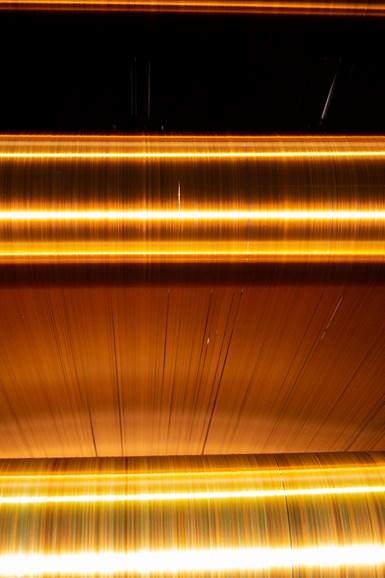
As the PAN fibers pass through the oxidation ovens, they gradually change color, from white to gold, to dark brass, to brown and then black. Temperatures here are 200-300°C; this is a highly exothermic process and temperature and air flow must be carefully controlled. Source | Hexcel
Riding this wave, Hexcel continued to expand its operations in Salt Lake City and through the 2000s built new weaving and prepregging facilities throughout the world, including in France, Germany, Spain, Morocco and China. Since acquiring Hercules in 1996, Hexcel has more than tripled its carbon fiber production capacity.
Carbon fiber manufacturing is a notoriously capital- and energy-intensive business, with a single, world-class, 2,000-metric-tonne line requiring as much as $60 million worth of equipment alone. Further, construction of a single line typically takes two to three years to complete. Because of this, it is difficult for carbon fiber producers to quickly respond to demand increases. The result is a de facto business model that requires developed and known technology, patience, deep pockets and a willingness to play a very long ROI game. This also creates a significant barrier to entry for firms not already making carbon fiber, thus the list of the world’s carbon fiber manufacturers is a relatively short one, and not growing quickly.
Historically, many carbon fiber producers have devoted a single line to manufacturing a single fiber type, with the goal of taking advantage of economies of scale and the efficiencies that come from no or minimal product variation. The vulnerability of this strategy is that demand reduction for a given line’s fiber type can cause a producer to slow or cease line production, causing a drag on profitability. Conversely, demand increase for a given fiber can be difficult to meet if production capacity is already maximized or if customers require a different fiber in new designs.
One strategy for coping with the onerous capital requirements of carbon fiber production is to build lines that offer flexibility — the ability to manufacture more than one fiber type, depending on customer and market demands. This is the strategy Hexcel has successfully adopted in its Salt Lake City and other plants.
Hexcel’s carbon fiber line
Hexcel’s carbon fiber manufacturing campus in West Valley City is located on a high plateau just east of Highway 85 and a 20-minute drive southwest of downtown Salt Lake City. The property is about a mile long and a quarter mile wide at its widest point, a collection of old and new buildings that tell the story of the site’s evolution from the late 1960s to today. Some of the original Hercules carbon fiber lines are housed in relatively small buildings; the newest lines are hard to miss — massive, quarter-mile long behemoths that belie the scale and intensity that are hallmarks of carbon fiber manufacturing today. CW’s tour at Hexcel took place in one of the newer buildings at the west end of the campus, which houses two carbon fiber lines. CW was shown line 13 which, on the day of our visit, was producing IMA fiber for the Airbus A350.
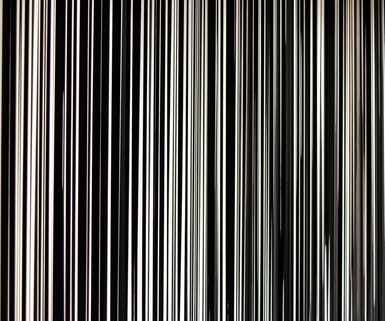
Carbon fiber, here in front of a lightboard, assumes its characteristic black color following oxidation. The next step is the all-important carbonization, accomplished via passes through two furnaces. The first (400-900°C) and the second (1000-1500°C) furnaces burn off about half the mass of the fiber and establish final fiber properties. For its high-modulus fibers, Hexcel uses a third furnace (2000+°C) to achieve graphitization. Source | Hexcel
Our guide was LaRhea McBee, senior carbon fibers technical support engineer and a veteran of carbon fiber manufacturing operations in West Valley City — her first paycheck was from Hercules, in 1985. McBee led us into line 13 at the east end of the building, explaining that line 13, although it was running IMA fiber at the moment, can be configured to produce any Hexcel intermediate or standard modulus carbon fiber.
Our first stop was a large bank of creels holding the white PAN fiber tows that feed the carbon fiber production line. These PAN creels, also called “cheeses” (a textile term, because wound fibers look like a cheese wheel), are organized into four sections, with two sections on each side of the racks. Each cheese creel is numbered and barcoded to provide full traceability.
PAN, in this form, is somewhat fragile, so the primary goal is to get the PAN tows off of each creel and fed into the carbon fiber line as carefully as possible. “We are trying to deliver that fiber off that spool with as little damage as possible to provide a high-quality finished product,” McBee says. “This is an important first step.” All of the tows are pulled in the same direction, toward a wall that separates the feed creel room from the rest of the carbon fiber line. As they approach the wall, the tows are brought together side-by-side, creating a 2-meter-wide band of fiber, which descends vertically over a roller near the ceiling, toward the floor, under another roller, and then horizontally toward a gap in the wall.
It’s at this point that the PAN fibers begin the oxidation process, the most time-consuming step in the manufacturing process. Here, the fibers are wound through a series of oxidation ovens at 200-300°C and gradually stretched and stabilized. The time, temperature and tension of the fibers in this stage affect the density, tensile strength and tensile modulus of the finished product. Oxidation is an exothermic process, so temperature and air flow must be closely controlled. The PAN fibers, which were white when they exited the creel racks in the previous room, gradually turn a brassy gold color, then dark brown and then black as they wind up and through the ovens during oxidation.
Following oxidation, the fiber then moves into the pyrolysis/carbonization stage, passing first through a low-temperature (400-900°C) furnace, and then a very high-temperature furnace, where temperatures range from 1,000-1,500°C. This is the most important step in the manufacturing process, with as much as 50% of the mass of the fiber burned off as the fibers assume the pure black color for which they are so well known. Ultimate density, tensile strength and tensile modulus of the fibers are set during pyrolysis/carbonization.
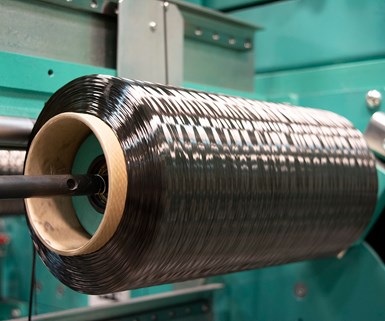
After carbonization, surface treatment and sizing application, each tow is separated and wound onto one of hundreds of spools arrayed at the end of the carbon fiber manufacturing line. Here, Hexcel employees carefully monitor the quantity of carbon fiber on each spool and doff (remove) the full ones to a storage container for inspection. Each spool is barcoded to match the barcode on the PAN creel from which the fiber started the manufacturing process. Source | Hexcel
Regardless of fiber type, what was once PAN fiber is now carbon fiber, and it emerges from the final carbonization furnace in a chemically inert state; primary fiber properties are now set. The next step in the process is surface treatment, where the fiber tows are passed through a bath that provides additional oxidation and prepares the fiber surface for sizing application. However, before that happens, operators working the line extract fiber samples from the tows for statistical process control (SPC) and quality control assessment. Following this, the fiber is sized to improve the physical handling attributes of the material. McBee says Hexcel has developed six types of sizing, designed to accommodate different fiber formats and resin use. Sizing levels range from 0.2-1.6%. McBee also notes that Hexcel has the option to leave the carbon fiber unsized for use with thermoplastic resin matrices.
Finally, a full 200 meters from where we started, the carbon fiber tows pass through another wall and into the winding and packing room. They enter from a height of about 15 feet and pass through widely spaced guides that direct the fibers down toward the production floor where banks of winders, each about 30 meters long, receive the tows. Each tow — and there are hundreds of them — is wound onto one spool, and that spool has the same number and same barcode as the original cheese of PAN we encountered at the start of the tour. A digital counter overhead tells operators how many meters of fiber have been delivered. McBee says fiber winding is the most complex part of fiber production as fiber must be under constant and correct tension to build a good spool.
The size of a finished spool varies, but can range up to 4.5 kilograms of carbon fiber, and when full is manually doffed from the winder and placed in one of several shipping containers throughout the winding area. “This is the finished product,” McBee says. “How it looks is important to our customers.”
Following winding, finished spools are moved to the final stop at the back of the production line where a six-axis robot automatically vision inspects each one for flaws. Spools that fail inspection are set aside; those that pass are re-boxed and prepared for shipment to either another Hexcel facility for prepregging or weaving, or to an outside customer.

After it’s wound, each spool is automatically scanned and assessed for quality. Those that pass inspection are poly-wrapped and then boxed for shipment to prepreggers or fabricators. Hexcel produces 45,000 miles of carbon fiber tows each day at its Salt Lake City campus. Source | Hexcel
The business of carbon fiber
Spending even a short time at Hexcel’s Salt Lake City campus, it’s quickly apparent how substantially industrialization of carbon fiber production has grown. The mix of older, smaller facilities cheek-by-jowl with larger, newer facilities (like line 13) tells the stark story of how quickly this industry has matured. Brett Schneider, president – global fibers at Hexcel, and the person most responsible for managing the company’s carbon fiber manufacturing strategy, says the scale and efficiency of carbon fiber production over the last decade has helped drive costs down and quality up.
“Lines are long, wide, fast and dense,” he says, adding that technical and chemical knowledge, combined with enabling data, have given all carbon fiber producers greater visibility into the manufacturing process. “Statistics have brought us knowledge, AI [artificial intelligence] has brought us knowledge, scale has brought us knowledge.”
Ten years ago, he says, “there were things — subatomic things — we thought we knew about carbon fiber manufacturing but could not measure. We can measure them now, and that has helped us see that there is even more that we would like to measure and control today, but we are not there yet.” For example, he says, fiber surface characteristics used to be measured using microscopy, with inferences and conclusions drawn from photographic evidence. Today, that’s done by directly measuring fiber atomic level data.
Looking to the future, Schneider believes that the product flexibility Hexcel has built into its carbon fiber lines positions the company to meet market demands that are becoming more complex, not less. “There are three variables in the process: Time, temperature and tension,” he notes, adding that in just a few hours Hexcel can convert a line from one carbon fiber product to another. “We’ve built assets that can manipulate time, temperature and tension that allow us to produce different products repeatably, quickly and efficiently.”
The carbon fiber market, as it entered 2020 (pre-pandemic) , Schneider says, was generally in balance between supply and demand for multiple fibers, depending on fiber type, tow count, and application. That balance, however, is “tight,” meaning that a demand surge from a market or customer could tip the supply chain into a fiber type shortage. Schneider points in particular to end segments that are poised for growth and being watched closely. These include urban air mobility (UAM), space, aerospace, defense, automotive, wind energy, pressure vessels and oil and gas.
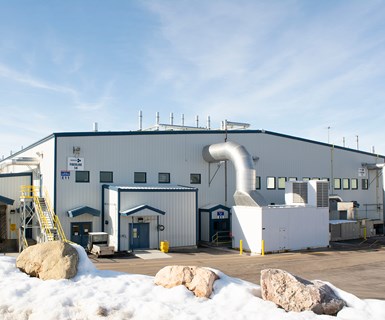
Hexcel Salt Lake City carbon fiber lines 13 and 14, exterior. Source | Hexcel
All of this matters because carbon fiber producers like Hexcel are disproportionately affected by over-the-horizon events, primarily because of the long lead time — three years —required to set up a new production line. “We don’t necessarily know what our customers will do next for consumption or technology selection,” Schneider says, “but when they make choices, we have to be ready with products and assets that can do the job.” Hence the product-flexible production lines.
Coping with the uncertainty of the future is a full-time job at Hexcel, Schneider reports. The company tracks trends and events that are likely to influence the uptake of composite materials in general, and carbon fiber in particular. These include a wide variety of macro commentary on GDP growth, aerospace traffic miles, space and defense objectives and light-weighting expectations in many segments.
“We look at all of these things through our strategic planning process,” he says, “we work closely with industry to be prepared to support the growth our customer’s want with a just-in-time asset readiness and material delivery model. We develop new technology in line with our customer’s goals and then build assets that can provide a flexible and secure supply chain to help them achieve those goals during adoption and production.”
The bottom line is that even if the world’s supply of carbon fiber is currently adequate, it certainly must grow to meet future demand as the world needs more lightweighting performance — regardless of the short-term impact of the coronavirus pandemic.
Hexcel, says Schneider, is land-locked at its Salt Lake City campus, which limits capacity expansion there. Hexcel’s facilities in Decatur, Ala., U.S., Illescas, Spain and Roussillon, France, however, each have room to grow. “When we need to expand, we have a plan for that and are prepared to do so. We have great technology and the financial wherewithal to support the growth our customers and the industry need in the future.”
Related Content
Plant tour: Airtech International, Springfield, Tenn., U.S.
Fifty years of supplying materials for composites manufacturing includes custom fabrication and now aims to advance 3D-printed tooling, parts and new resins.
Read MorePlant tour: Aernnova Composites, Toledo and Illescas, Spain
RTM and ATL/AFP high-rate production sites feature this composites and engineering leader’s continued push for excellence and innovation for future airframes.
Read MorePlant tour: Spirit AeroSystems, Belfast, Northern Ireland, U.K.
Purpose-built facility employs resin transfer infusion (RTI) and assembly technology to manufacture today’s composite A220 wings, and prepares for future new programs and production ramp-ups.
Read MorePlant tour: Arris Composites, Berkeley, Calif., U.S.
The creator of Additive Molding is leveraging automation and thermoplastics to provide high-volume, high-quality, sustainable composites manufacturing services.
Read MoreRead Next
VIDEO: High-volume processing for fiberglass components
Cannon Ergos, a company specializing in high-ton presses and equipment for composites fabrication and plastics processing, displayed automotive and industrial components at CAMX 2024.
Read MoreDeveloping bonded composite repair for ships, offshore units
Bureau Veritas and industry partners issue guidelines and pave the way for certification via StrengthBond Offshore project.
Read More“Structured air” TPS safeguards composite structures
Powered by an 85% air/15% pure polyimide aerogel, Blueshift’s novel material system protects structures during transient thermal events from -200°C to beyond 2400°C for rockets, battery boxes and more.
Read More
















